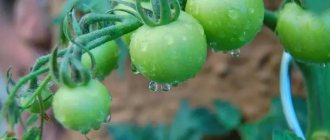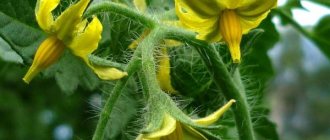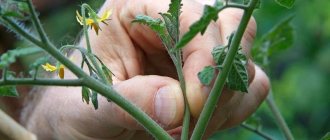For every farmer, increasing productivity and income from the garden is a top priority. Science and breeders armed with it come to the aid of summer residents. Today, many different varieties of tomatoes have been developed that meet a wide variety of requirements. One of the most popular species is the "Bull's Heart", an amazing hybrid in all respects. However, all its qualities are fully manifested only if the growing conditions are fully observed, which means you need to carefully familiarize yourself with the characteristics of this species.
Advantages and disadvantages of the variety
Advantages of the Ox Heart variety:
- large-fruited fruits, especially on the lower clusters;
- very tender, sweet and fleshy pulp;
- there are various subspecies;
- has a high germination rate of planting material;
- the fruits set together;
- good yield indicators;
- can be grown both in a greenhouse and in open ground;
- plants are drought resistant;
- immunity to most diseases, in particular late blight.
Flaws:
- the need for stepson, formation and garter of bushes;
- If not properly cared for, it can be affected by certain types of diseases.
Procurement of seeds
The variety is not a hybrid; it does not have the F1 prefix, which pleases gardeners. For further cultivation, you can always collect your own planting material.
The ripest fruit that has ripened under natural conditions is left for the seeds. After which it is cut, the pulp with seeds is scooped out with a spoon and left to ferment in a saucer. When bubbles appear, the pulp is washed off under running water. The seeds are dried and placed in paper bags.
Important! Tomato seeds can be stored for 3 years.
Conclusion
The variety deserves the attention of gardeners. This is the most productive tomato that does not require much effort in growing. If you create all the conditions, a good harvest is guaranteed.
Productivity
- When grown in open ground, you can collect up to 5 kg from one bush.
- When growing tomatoes in greenhouse conditions, the yield can be increased to 12 kg per bush.
You can harvest such a harvest only if you choose good seeds and also adhere to all the rules for caring for plants of this variety.
The fruits can be collected both at the technical stage of ripeness (greenish tomatoes) and at the biological stage (red tomatoes). But while the tomatoes are still unripe, it will be difficult to understand whether they have reached their size or will continue to grow.
Therefore, if there is a need to remove unripe tomatoes, then you should focus on changing the color. As soon as a yellow or brown tint appears, you can pick it.
Tomatoes ripen well on a windowsill, in a box or in a basket. Just lay out the fruits in 1 or 2 layers.
Growing Oxheart tomatoes at home
The Ox Heart tomato variety and any of the varieties bred on its basis are not very suitable for growing at home. The main reason is the size of the plant. There is not enough space for such bushes even on the balcony, let alone on the windowsill. Their root system is powerful and developed; it will not do well in a cramped pot.
In addition, early-ripening varieties with a ripening period of no more than 90–100 days are most often chosen for planting at home. The bull's heart does not satisfy this criterion either.
For planting on the windowsill and on the balcony, tomato varieties are chosen whose appearance is radically different from the exterior of the Bull's Heart
It is difficult to provide plants of this variety with nutrients in the required volume. If they are deficient, the fruits simply will not ripen. But raising the dose or shortening the intervals between feedings is also not an option.
Ideal for the windowsill are super-determinate varieties of tomatoes from the category of ampelous or standard tomatoes, the bush of which does not extend more than 0.5 m in height. It is also desirable that they be small-fruited - such tomatoes ripen faster. As you can easily see, Bull's Heart is a completely different story.
Variety varieties
Golden Bull's Heart
The difference between Bull's Heart and other varieties is that the variety has several subspecies that differ in color. In addition to traditional red tomatoes (red ox heart), there are the following varieties:
- Golden Bull's Heart. The fruits of this subspecies are cone-shaped and golden-yellow in color. The weight of tomatoes is 400-750 grams. The skin is dense. The taste is sweet. The yield is average, lower than that of the “red heart”.
- Pink Ox heart. The tomatoes are bright pink. The weight of the fruit reaches 1 kilogram. The skin is thin but dense. Maturation occurs a little later than other species. The fruits are very well stored. Plants have increased resistance to various diseases. Easy care and many advantages make this variety of Ox's Heart quite popular among gardeners.
- White Bull's Heart. The fruits of this variety are white. The weight of a tomato can reach up to 800-900 grams. Fruits for a long time. Fruiting stops immediately after the onset of the first cold weather.
White Bull's Heart - Orange Bull's Heart. The fruits are orange in color. The weight of a tomato reaches 1 kilogram. The plant is resistant to dry weather and is rarely susceptible to disease. Requires very frequent pinching.
- Black Bull Heart. The fruits are burgundy-brown. The weight of the fruit is about 600-700 grams, but ripening is very long. They have tender pulp with almost no seeds. The variety is distinguished by good yield. Often the fruits ripen simultaneously on all clusters.
Black Bull Heart
Features of cultivation and care
The variety has a long growing season, so it is recommended to grow it only through seedlings. The optimal age for planting tomatoes in a permanent place of growth is 50-70 days.
- Before planting, the seeds must be scalded with boiling water to kill all fungi on their surface. It is also recommended to disinfect the soil by pouring boiling water over it.
- The seeds are sown in the prepared soil to a depth of no more than 2 cm. The distance between the seeds is at least 1.5-2 cm. The plantings are covered with film and taken out to a dark, warm place.
- When the sprouts hatch, the film is removed and the containers are transferred to a windowsill or under a fluorescent lamp.
- In the phase of 2-3 leaves, seedlings are planted in separate containers. Seedlings are fertilized once every 14 days. Use complex fertilizers for tomato seedlings.
- 7-10 days before planting in a permanent place, the seedlings are hardened, that is, taken out into the fresh air. First for 1–2 hours, and then the time is increased to the whole day.
Planting in a greenhouse
When the seedlings grow to 20-25 cm in height, they need to be transplanted into a greenhouse. As a rule, this is done in mid-April. The greenhouse should be well heated and well lit.
Seedlings are planted at a distance of one meter from each other. I make holes 15 cm deep and add humus. After planting, the plants are watered well with warm water.
Greenhouse care
The air temperature in the greenhouse is maintained at 20-22 °C during the day and 16-18 °C at night. Water the plants once every 7 days. For 1 sq. meter uses about 7 liters of water. During the period of fruit formation, the amount of water is increased to 15 liters per 1 square meter. meter.
The greenhouse is ventilated every day for 30 minutes. Tomatoes are pollinated by hand. The bush must be formed and the stepsons removed. Organic fertilizers are applied every two weeks.
Growing tomatoes in open ground
The bed has been prepared since the fall. All weeds are removed, rotted manure is added, and the soil is dug well. Seedlings are planted in early May.
Care
Plants are fed 2 weeks after planting with organic fertilizers.
- After the first feeding, a layer of mulch no more than 5 cm thick is poured onto the ground. Pine needles, sawdust or straw are used.
- The plants are fed a second time ten days after the first ovaries appear. 2 liters of manure solution are poured under one tomato bush.
- The plants are fed the third time during the ripening period. Pour 2.5 liters of manure solution under each tomato bush.
Water the plants strictly at the roots, twice a week. If the weather is hot - 3-4 times a week. Also, the bushes are formed, tied to a trellis and the stepsons are cut off.
Resistance to diseases and pests, methods of prevention
The variety does not have excellent immunity, so for prevention purposes the bushes must be sprayed regularly. For diseases, use a solution of Bordeaux mixture. At the beginning of the growing season, make a 3% mixture, then switch to 1%.
For opponents of chemicals on the site, there are traditional methods, for example, treatment with a solution of serum with iodine. To 10 liters of water add 2 liters of whey and 15 drops of iodine. Spraying is repeated every 15 days and after rain.
Important! The lower fruits, shoots and stems of the plant are sprayed especially carefully.
Reviews from gardeners who planted the variety
Angelina
I really liked the variety - productive, disease-free, tasty fruits. Mid-season, tall, ind. variety. Sets fruit under unfavorable conditions, does not shed the ovary. When the plant is formed into one stem, there may be giant fruits. The taste is excellent, sweet, sugary.
Lana_s_Kavkaza, Pyatigorsk
Large bull's heart from Sivukha. I liked the variety, all the fruits are large, heart-shaped, the flesh is dense and fleshy. Mid-season, tall, 1.6-1.8 m in the western part. Quite large fruits, rich, balanced taste.
Fairy
I had it from the Russian Vegetable Garden and planted it in 2022. The shape was somehow not heart-shaped, but otherwise it was good! Large-fruited, tasty, meaty. Despite the thin skin, it lay there and was eaten in the last rows.
Ninulia, southeast of the Nizhny Novgorod region
I really liked the variety. The tomatoes were large and very tasty! And they didn’t hurt us with the harvest!
History of creation
According to some sources, Bull's Heart is a variety of folk selection that came to us from Italy, according to others, it comes from the Stavropol Territory. Despite the fact that large sweet tomatoes were successfully grown at the beginning of the last century, in Russia only in 2001 an application was submitted for registration of the variety in the State Register. After 2 years, it was recognized as a selection achievement and allowed to be grown throughout the Russian Federation. The copyright holder was the agricultural company Search.
Many hybrids of Ox Heart have been bred, differing in ripening time and color - the fruits can be not only red, but also amber, orange, crimson and even almost black.











